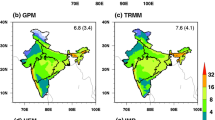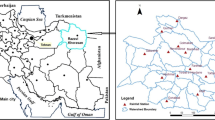Abstract
In this paper, Kalpana-1 derived INSAT Multispectral Rainfall Algorithm (IMSRA) rainfall estimates are compared with two multisatellite rainfall products namely, TRMM Multisatellite Precipitation Analysis (TMPA)-3B42 and Global Satellite Mapping of Precipitation (GSMaP), and India Meteorological Department (IMD) surface rain gauge (SRG)-based rainfall at meteorological sub-divisional scale over India. The performance of the summer monsoon rainfall of 2013 over Indian meteorological sub-divisions is assessed at different temporal scales. Comparison of daily accumulated rainfall over India from IMSRA shows a linear correlation of 0.72 with TMPA-3B42 and 0.70 with GSMaP estimates. IMSRA is capable to pick up daily rainfall variability over the monsoon trough region as compared to TMPA-3B42 and GSMaP products, but underestimates moderate to heavy rainfall events. Satellite-derived rainfall maps at meteorological sub-divisional scales are in reasonably good agreement with IMD-SRG based rainfall maps with some exceptions. However, IMSRA performs better than GSMaP product at meteorological sub-divisional scale and comparable with TMPA data. All the satellite-derived rainfall products underestimate orographic rainfall along the west coast, the Himalayan foothills and over the northeast India and overestimate rainfall over the southeast peninsular India. Overall results suggest that IMSRA estimates have potential for monsoon rainfall monitoring over the Indian meteorological sub-divisions and can be used for various hydro-meteorological applications.








Similar content being viewed by others
References
Das, S. K., Deb, S. K., Kishtawal, C. M., & Pal, P. K. (2013). Seasonal prediction of Indian summer monsoon: sensitivity to persistent SST. Journal of Earth System Science, 122, 1183–1193. doi:10.1007/s12040-013-0351-6.
Gadgil, S. (2003). The Indian monsoon and its variability. Annual Review of Earth and Planetary Sciences, 31, 429–467. doi:10.1146/annurev.earth.31.100901.141251.
Gadgil, S., & Srinivasan, J. (2010). Understanding and predicting the Indian summer monsoon. Current Science, 99, 1184–1186.
Gairola, R. M., Varma, A. K., Prakash, S., Mahesh, C., &, Pal, P. K. (2010b). Development of rainfall estimation algorithms for monitoring rainfall events over India using KALPANA-IR measurements on various temporal and spatial scales. 38th meeting of the Co-ordination Group of Meteorological Satellites (CGMS) 8–12 Nov., New Delhi, India.
Gairola, R. M., Mishra, A., Prakash, S., & Mahesh, C. (2010a). Development of INSAT Multi-Spectral Rainfall Algorithm (IMSRA) for monitoring rainfall events over India using KALPANA-IR and TRMM-Precipitation Radar observations. Scientific Report SAC/EPSA/AOSG/INSAT/SR-39/2010, 22pp.
Gairola, R. M., Prakash, S., Bushair, M. T., & Pal, P. K. (2014). Rainfall estimation from Kalpana-1 satellite data over Indian land and oceanic regions. Current Science, 107, 1275–1282.
Gairola, R. M., Prakash, S., & Pal, P. K. (2015). Improved rainfall estimation over the Indian monsoon region by synergistic use of Kalpana-1 and rain gauge data. Atmosfera, 28, 51–61.
Goswami, B. N., & Ajayamohan, R. S. (2001). Intraseasonal oscillations and interannual variability of the Indian summer monsoon. Journal of Climate, 14, 1180–1198.
Houze, R. A., Jr. (2012). Orographic effects on precipitating clouds. Reviews of Geophysics, 50, RG1001. doi:10.1029/2011RG000365.
Huffman, G. J., & Bolvin, D. T. (2013). TRMM and other data precipitation data set documentation. Global Change Master Directory, NASA, 40pp. [Available online at ftp://precip.gsfc.nasa.gov/pub/trmmdocs/3B42_3B43_doc.pdf].
Huffman, G. J., Adler, R. F., Bolvin, D. T., Gu, G., Nelkin, E. J., Bowman, K. P., Hong, Y., Stocker, E. F., & Wolff, D. B. (2007). The TRMM multisatellite precipitation analysis (TMPA): Quasi-global, multiyear, combined-sensor precipitation estimates at fine scales. Journal of Hydrometeorology, 8, 38–55. doi:10.1175/JHM560.1.
Huffman, G. J., Adler, R. F., Bolvin, D. T., & Nelkin, E. J. (2010). The TRMM Multi-satellite Precipitation Analysis (TMPA). In F. Hossain and M. Gebremichael (Eds.) Satellite applications for surface hydrology (pp. 3–22). Springer Verlag. ISBN: 978-90-481-2914-0.
IMD. (2013). Monsoon 2013: A report. New Delhi: India Meteorological Department.
Kaila, V. K., Kiran Kumar, A. S., Sundarmurthy, T. K., Ramkrishnan, S., Prasad, M. V. S., Desai, P. S., Jayaraman, V., & Manikiam, B. (2002). METSAT—a unique mission for weather and climate. Current Science, 83, 1081–1088.
Kotal, S. D., Roy, S. S., & Roy Bhowmik, S. K. (2014). Catastrophic heavy rainfall episode over Uttarakhand during 16–18 June 2013—observational aspects. Current Science, 107, 234–245.
Krishnamurthy, V., & Shukla, J. (2007). Intraseasonal and seasonally persisting patterns of Indian monsoon rainfall. Journal of Climate, 20, 3–20. doi:10.1175/JCI3981.1.
Kucera, P. A., Ebert, E. E., Turk, F. J., Levizzani, V., Kirschbaum, D., Tapiador, F. J., Loew, A., & Borsche, M. (2013). Precipitation from space: advancing earth system science. Bulletin of the American Meteorological Society, 94, 365–375. doi:10.1175/BAMS-D-11-00171.1.
Mahesh, C., Prakash, S., Gairola, R. M., Shah, S., & Pal, P. K. (2014). Meteorological sub-divisional scale rainfall monitoring using Kalpana-1 VHRR measurements. Geographical Research, 52, 328–336. doi:10.1111/1745-5871.12068.
Mishra, A., & Srinivasan, J. (2013). Did a cloud burst occur in Kedarnath during 16 and 17 June 2013? Current Science, 105, 351–1352.
Mishra, A., Gairola, R. M., Varma, A. K., & Agarwal, V. K. (2010). Remote sensing of precipitation over Indian land and oceanic regions by synergistic use of multisatellite sensors. Journal of Geophysical Research, 115, D08106. doi:10.1029/2009JD012157.
Parthasarathy, B., Sontakke, N. A., Monot, A. A., & Kothawale, D. R. (1987). Droughts/floods in the summer monsoon season over different meteorological subdivisions of India for the period 1871–1984. Journal of Climatology, 7, 57–70. doi:10.1002/joc.3370070106.
Prakash, S., Mahesh, C., Mishra, A., Gairola, R. M., Varma, A. K., & Pal, P. K. (2009). Combined use of microwave and IR data for the study of Indian monsoon rainfall-2009. ISPRS Archives XXXVIII-8/W3 Workshop Proceedings: Impact of Climate Change on Agriculture. Ahmedabad
Prakash, S., Mahesh, C., Gairola, R. M., & Pal, P. K. (2010). Estimation of Indian summer monsoon rainfall using Kalpana-1 VHRR data and its validation using rain gauge and GPCP data. Meteorology and Atmospheric Physics, 110, 45–57. doi:10.1007/s00703-010-0106-8.
Prakash, S., Mahesh, C., Gairola, R. M., & Buyantogtokh, B. (2012). A feasibility of six-hourly rainfall forecast over central India using model output and remote sensing data. International Journal of Hydrology Science and Technology, 2, 138–152. doi:10.1504/IJHST.12.47409.
Prakash, S., Sathiyamoorthy, V., Mahesh, C., & Gairola, R. M. (2014). An evaluation of high-resolution multisatellite rainfall products over the Indian monsoon region. International Journal of Remote Sensing, 35, 3018–3035. doi:10.1080/01431161.2014.894661.
Revadekar, J. V., & Preethi, B. (2010). Statistical analysis of the relationship between summer monsoon precipitation extremes and food grain yield over India. International Journal of Climatology, 32, 419–429. doi:10.1002/joc.2282.
Roy, S. S., Saha, S. B., Fatima, H., Roy Bhowmik, S. K., & Kundu, P. K. (2012). Evaluation of short period rainfall estimates from Kalpana-1 satellite using MET software. Journal of Earth System Science, 121, 1113–1123.
Srinivasan, J., & Joshi, P. C. (2007). What have we learned about the Indian monsoon from satellite data? Current Science, 93, 165–172.
Srivastava, A. K., Guhathakurtha, P., & Kaur, S. (2014). Rainfall statistics. In Monsoon 2013: a report (pp. 18–36), ESSO/IMD/SYNOPTIC MET/01-2014/15.
Tapiador, F. J., Turk, F. J., Petersen, W., Hou, A. Y., Garcia-Ortega, E., Machado, L. A. T., Angelis, C. F., Salio, P., Kidd, C., Huffman, G. J., & de Castro, M. (2012). Global precipitation measurement: methods, datasets and applications. Atmospheric Research, 104–105, 70–97. doi:10.1016/j.atmosres.2011.10.021.
Tobin, K. J., & Bennett, M. E. (2014). Satellite precipitation products and hydrologic applications. Water International, 39, 360–380. doi:10.1080/02508060.2013.870423.
Ushio, T., Kubota, T., Shige, S., Okamoto, K., Aonashi, K., Inoue, T., Takahashi, N., Iguchi, T., Kachi, M., Oki, R., Morimoto, T., & Kawasaki, Z. (2009). A Kalman filter approach to the Global Satellite Mapping of Precipitation (GSMaP) from combined passive microwave and infrared radiometric data. Journal of the Meteorological Society of Japan, 87A, 137–151.
Yong, B., Chen, B., Gourley, J. J., Ren, L., Hong, Y., Chen, X., Wang, W., Chen, S., & Gong, L. (2014). Intercomparison of the version-6 and version-7 TMPA precipitation products over high and low latitudes basins with independent gauge networks: is the newer version better in both real-time and post-real-time analysis for water resources and hydrologic extremes? Journal of Hydrology, 508, 77–87. doi:10.1016/j.jhydrol.2013.10.050.
Zulkafli, Z., Buytaert, W., Onof, C., Manz, B., Tarnavsky, E., Lavado, W., & Guyot, J. L. (2014). A comparative performance analysis of TRMM 3B42 (TMPA) versions 6 and 7 for hydrological applications over Andean-Amazon river basins. Journal of Hydrometeorology, 15, 581–592. doi:10.1175/JHM-D-13-094.1.
Acknowledgments
The authors would like to express their thanks to the Director of the Space Applications Centre and the Deputy Director of the EPSA for their encouragement and keen interest for the research carried out in this study. They also wish to acknowledge the editor and two anonymous reviewers for constructive comments. The TRMM-3B42 data from TRMM Online Visualization and Archive System (TOVAS), GSMaP data from JAXA and Kalpana-1 data provided by the MOSDAC, ISRO and rainfall maps obtained from the IMD are acknowledged with sincere thanks.
Author information
Authors and Affiliations
Corresponding author
About this article
Cite this article
Bushair, M.T., Prakash, S., Patel, S. et al. Assessment of Kalpana-1 Rainfall Product over Indian Meteorological Sub-Divisions During the Summer Monsoon Season. J Indian Soc Remote Sens 44, 67–76 (2016). https://doi.org/10.1007/s12524-015-0465-1
Received:
Accepted:
Published:
Issue Date:
DOI: https://doi.org/10.1007/s12524-015-0465-1




